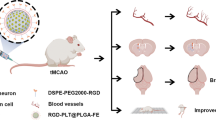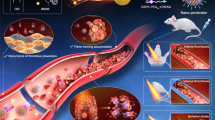Abstract
In order to examine the effect of EGF1 peptides in directing nanoparticles to thrombi, the synthesized EGF1 peptide was conjugated to poly (ethyleneglycol)-poly (lactide) (PEG-PLA) nanoparticles (NP) to form EGF1-NP. A lipophilic fluorescent dye, coumarin-6, was incorporated into EGF1-NP so as to detect its loading and release capacity. The binding ability of EGF1-NP with TF-expressing cells was shown to be significantly higher than that of the non-conjugated NP. Following an intravenous administration, fluorescence was distributed along the vessel wall of the thrombosis regions in the model rats injected with coumarin-6-loaded EGF1-NP. The in vitro and in vivo results suggest that EGF1-NP is a promising drug delivery system for targeting cerebral thrombi.
Similar content being viewed by others
References
William L D, David A V. Multi-Bed vascular disease and atherothrombosis: Scope of the Problem. J Thromb Thrombolysis, 2004, 17: 51–61
Fitzmaurice D A, Blann A D, Lip G Y. Bleeding risks of antithrombotic therapy. Brit Med J, 2002, 325: 828–831
Toyoda K, Yasaka M, Iwade K, et al. Dual antithrombotic therapy increases severe bleeding events in patients with stroke and cardiovascular disease: A prospective, multicenter, observational study. Strok, 2008, 39: 1740–1745
Elkind M S. Outcomes after stroke: Risk of recurrent ischemic stroke and other events. Am J Med, 2009, 122: S7–13
Lee V M, Burdett N G, Carpenter T A, et al. Evolution of photochemically induced focal cerebral ischemia in the rat. Stroke, 1996, 27: 2110–2119
Hagen F S, Gray C L, O’Hara P, et al. Characterization of a cDNA encoding for human FVII. Proc Natl Acad Sci USA, 1986, 83: 2412–2416
Pike A C, Brzozowski A M, Roberts S M, et al. Structure of human factor VIIa and its implications for the triggering of blood coagulation. Proc Natl Acad Sci USA, 1999, 96: 8925–8930
Mei H, Hu Y, Wang H, et al. Binding of EGF1 domain peptide in coagulation factor VII with tissue factor and its implications for the triggering of coagulation. J Huazhong Univ Sci Technolog Med Sci, 2010, 30: 42–47
Huwyler J, Wu D, Pardridge W M. Brain drug delivery of small molecules using immunoliposomes. Proc Natl Acad Sci USA, 1996, 93: 14164–14169
Ellman G L. Tissue sulfhydryl groups. Arch Biochem Biophys, 1959, 82: 70–77
Dong Y, Feng S S. Methoxy poly(ethylene glycol)-poly (lactide) (MPEG-PLA) nanoparticles for controlled delivery of anticancer drugs. Biomaterials, 2004, 25: 2843–2849
Lu W, Zhang Y, Tan Y Z, et al. Cationic albumin-conjugated pegylated nanoparticles as novel drug carrier for brain delivery. J Control Release, 2005, 107: 428–448
Olivier J C, Huertas R, Lee H J, et al. Synthesis of pegylated immunonanoparticles. Pharm Res, 2002, 19: 1137–1143
Engelmann B, Zieseniss S, Brand K, et al. Tissue factor expression of human monocytes is suppressed by lysophosphatidylcholine. Arterioscler Thromb Vasc Biol, 1999, 19: 47–53
Lee V M, Burdett N G, Carpenter T A, et al. Evolution of photochemically induced focal cerebral ischemia in the rat. Stroke, 1996, 27: 2110–2119
Calvo P, Gouritin B, Chacun H, et al. Longcirculating PEGylated polycyanoacrylate nanoparticles as new drug carrier for brain delivery. Pharm Res, 2001, 18: 1157–11661
Author information
Authors and Affiliations
Corresponding author
About this article
Cite this article
Mei, H., Pang, Z., Hu, Y. et al. Effect of EGF1 peptides in directing nanoparticles to thrombi. Chin. Sci. Bull. 55, 3424–3429 (2010). https://doi.org/10.1007/s11434-010-4105-8
Received:
Accepted:
Published:
Issue Date:
DOI: https://doi.org/10.1007/s11434-010-4105-8




